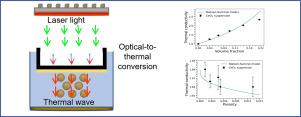Study of the thermal conductivity of solid–liquid suspensions formed by mesoporous cerium oxide particles
IF 5
2区 工程技术
Q1 ENGINEERING, MECHANICAL
International Journal of Thermal Sciences
Pub Date : 2025-10-10
DOI:10.1016/j.ijthermalsci.2025.110363
引用次数: 0
Abstract
This investigation employs the thermal wave resonator cavity (TWRC) technique to obtain the thermal diffusivity and quantify the thermal conductivity in suspensions composed of ethylene glycol loaded with mesoporous cerium oxide particles stabilized by Pluronic F-127. An analytical framework is proposed by combining the Lewis-Nielsen effective thermal conductivity model for composite materials with the Sumirat–Ando–Shimamura model for nanoporous materials to quantitatively describe the effects of volume fraction and porosity on thermal transport properties. This combined approach establishes a three-dimensional functional relationship between the thermal conductivity, porosity, and volume fraction. The mathematical model provides information on non-ideal particle packing configurations at high concentrations, enabling the predictive determination of suspension thermal conductivity based on microstructural parameters.

介孔氧化铈颗粒固液悬浮液的导热性能研究
本研究采用热波谐振腔(TWRC)技术获得了由Pluronic F-127稳定的介孔氧化铈颗粒负载的乙二醇组成的悬浮液的热扩散系数,并量化了其热导率。结合复合材料的Lewis-Nielsen有效导热系数模型和纳米多孔材料的Sumirat-Ando-Shimamura模型,提出了一个定量描述体积分数和孔隙率对热输运性能影响的分析框架。这种组合方法建立了导热系数、孔隙度和体积分数之间的三维函数关系。该数学模型提供了高浓度下非理想颗粒堆积构型的信息,从而能够基于微观结构参数预测悬浮液的导热系数。
本文章由计算机程序翻译,如有差异,请以英文原文为准。
求助全文
约1分钟内获得全文
求助全文
来源期刊

International Journal of Thermal Sciences
工程技术-工程:机械
CiteScore
8.10
自引率
11.10%
发文量
531
审稿时长
55 days
期刊介绍:
The International Journal of Thermal Sciences is a journal devoted to the publication of fundamental studies on the physics of transfer processes in general, with an emphasis on thermal aspects and also applied research on various processes, energy systems and the environment. Articles are published in English and French, and are subject to peer review.
The fundamental subjects considered within the scope of the journal are:
* Heat and relevant mass transfer at all scales (nano, micro and macro) and in all types of material (heterogeneous, composites, biological,...) and fluid flow
* Forced, natural or mixed convection in reactive or non-reactive media
* Single or multi–phase fluid flow with or without phase change
* Near–and far–field radiative heat transfer
* Combined modes of heat transfer in complex systems (for example, plasmas, biological, geological,...)
* Multiscale modelling
The applied research topics include:
* Heat exchangers, heat pipes, cooling processes
* Transport phenomena taking place in industrial processes (chemical, food and agricultural, metallurgical, space and aeronautical, automobile industries)
* Nano–and micro–technology for energy, space, biosystems and devices
* Heat transport analysis in advanced systems
* Impact of energy–related processes on environment, and emerging energy systems
The study of thermophysical properties of materials and fluids, thermal measurement techniques, inverse methods, and the developments of experimental methods are within the scope of the International Journal of Thermal Sciences which also covers the modelling, and numerical methods applied to thermal transfer.
 求助内容:
求助内容: 应助结果提醒方式:
应助结果提醒方式:


